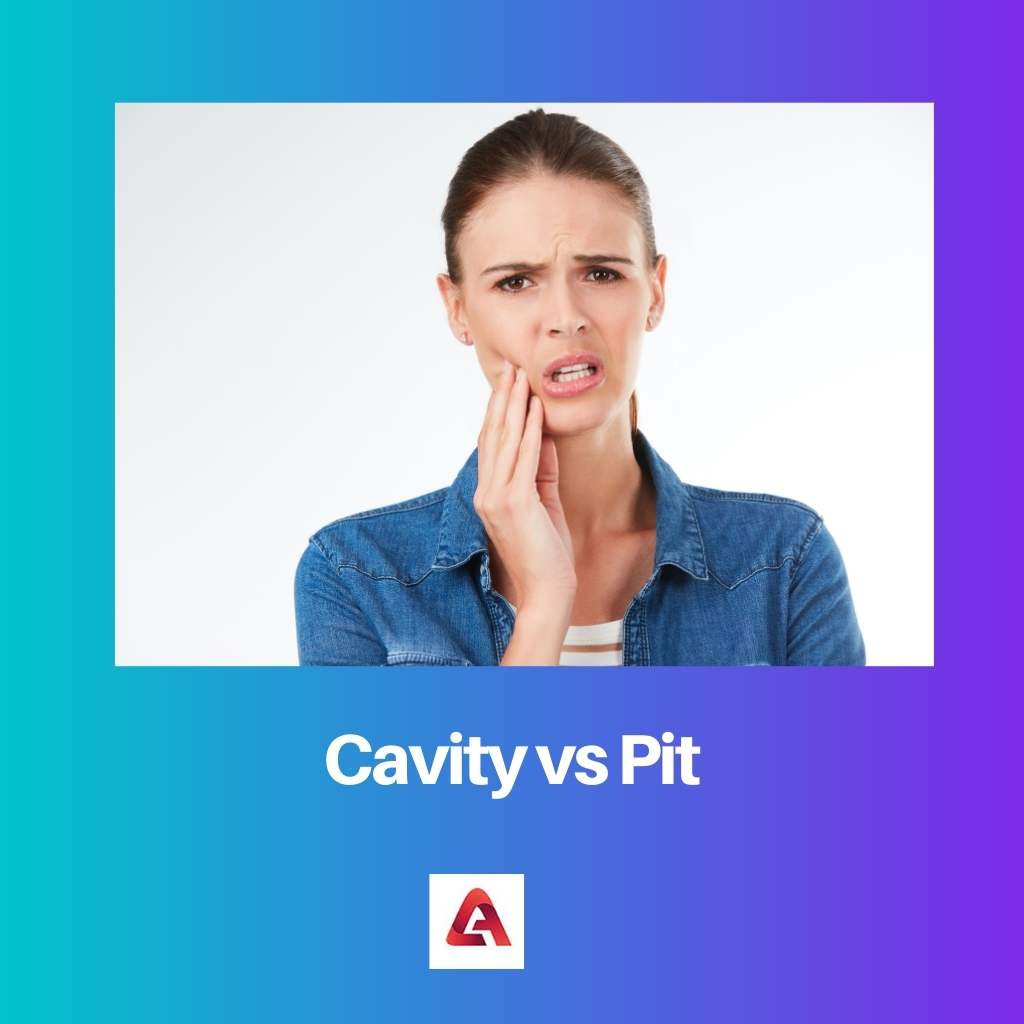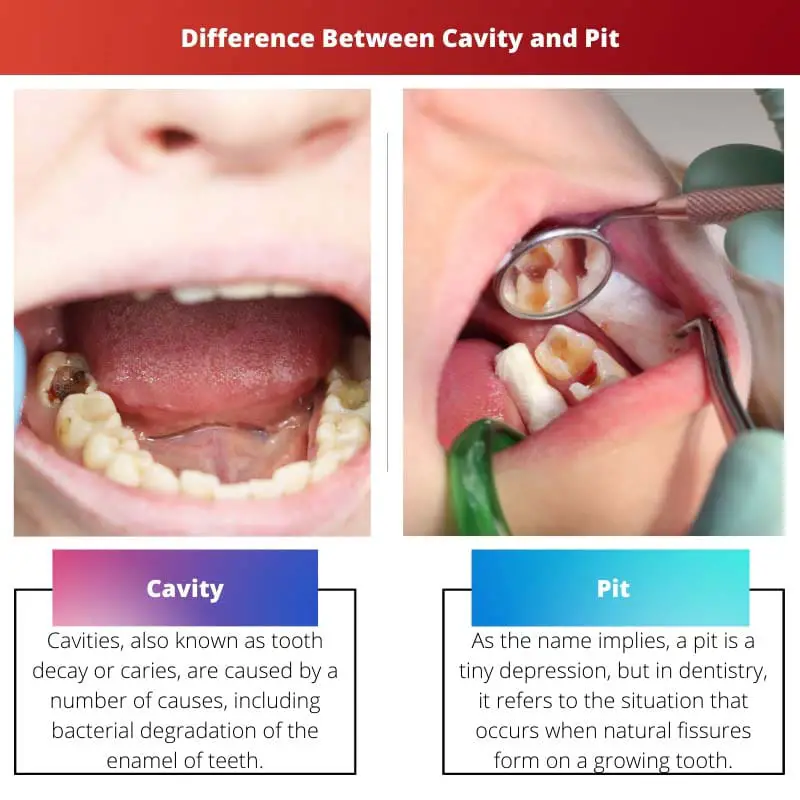Both the terms “cavity” and “pit” allude to openings or holes of some sort. They’re employed in a variety of settings, such as “pleural space,” dental cavity or fissure as well as tooth pit.
The term refers to the body cavity, or “hole,” as in “a pit in the earth.” We will distinguish between these two words in the realm of dentistry in this article.
The differences between a dental cavity and a pit are very crucial and less known. So, this article will focus on the meanings, symptoms, and appearance of both cavity and pit with the help of a descriptive table and distinguished points on both.
Key Takeaways
- A cavity is a decayed tooth area caused by bacteria eroding the enamel and dentin.
- A pit is a small depression or hole on the surface of a tooth, which can be a risk factor for developing cavities.
- A cavity is an area of decay, while a pit is a small depression on the tooth surface.
Cavity vs Pit
Cavity means a small hole in a solid space or on a form. It is an empty space inside a tooth caused by the bacteria and germs in the teeth. A tooth with cavity is mostly blue and black with space in the center. Pit is a small depression on the surface of a teeth caused naturally due to continuous chewing and eating.

In dentistry, the word “cavity” refers to a gap or hole developed in the teeth as a result of decay. The disintegration of decaying teeth causes this gap or cavity to appear.
Dental decay, or cavities, is another name for it. Cavities occur in teeth when bits of food that have been left in the tooth begin to rot and disintegrate.
They become lodged in the crevices between the teeth, where germs thrive and cause lasting damage and decay. Because the bacteria generate acids, the harm is permanent.
The hydrolysis reaction produces these acids, and they begin to weaken and dematerialize the pulp and enamel of the molars or premolars.
Talking about a dental pit, this phenomenon occurs either by birth or gradually with due course of time. In dentistry, the term “pit” is used to describe fissures and natural dents on the tooth enamel.
A pit seems to be a very tiny depression that develops when teeth expand. Pits are most commonly observed in the tooth valleys.
They’re the tiny depressions or crevices where food gets trapped, and deterioration begins due to bacterial development. Pores most occur in the pits of the teeth and the gaps between them.
Comparison Table
| Parameters of Comparison | Cavity | Pit |
|---|---|---|
| Meaning | Cavities, also known as tooth decay or caries, are caused by a number of causes, including bacterial degradation of the enamel of teeth. | As the name implies, a pit is a tiny depression, but in dentistry, it is when natural fissures form on a growing tooth. |
| Cause | Improper dental care, not brushing regularly, Excessive sweet or acidic food consumption. | By birth or by developing teeth caps. |
| Transformation | Cavities transform into lethal decay caries that cause gum loosening and toothache with loss of teeth. | It can transform into cavities if not cleaned and brushed properly. |
| Preventive Measures | Regular brushing, flossing, and dental checkups. | Applying sealants and brushing regularly. |
| Count | 1 out of 5 people have a minute risk of untreated cavities. | 1 out of 4 people throughout the world population have a minute risk of dental pits. |
What is Cavity?
Cavities are small gaps or holes in the tooth’s hard surface that is damaged beyond repair.
Cavities, also known as tooth decay or caries, are caused by several causes, including germs in the mouth, excessive eating, drinking sweetened sodas, and not brushing your teeth thoroughly.
Cavities and dental decay are two of the most frequent health issues worldwide. Children, teens, and elderly individuals are more susceptible. Cavities may affect anybody with teeth, even newborns.
Cavities that aren’t fixed get stronger and harm different levels of your enamel if they aren’t cured. They can cause a lot of pain, inflammation, and loss of teeth.
Your best defense against dental problems is dental cleanings, checkup appointments, and proper brushing and flossing practices.
The plaque causes cavities, and it begins to take up the fissures of your teeth. Plaque is a sticky, transparent film that covers your teeth. It’s caused by a diet high in sweets and carbohydrates and a lack of dental hygiene.
When carbs aren’t removed from your tooth, microbes feast on all of them, and plaque forms. Tartar may form when plaque remains on your teeth, either below or above the gum line (calculus).
Tartar renders plaque removal harder and acts as a barrier for germs.

What is a Pit?
The terminology “pit” is commonly used in dental science. As the name implies, a pit is a tiny depression, but in dentistry, it is when natural fissures form on a growing tooth.
Because of their substrate specificity, pits or cracks on the incisal edges of primary molars are more prone to cavity formation than smooth surfaces, rendering dental care more difficult and leading to greater plaque buildup.
When compared to the enamel on smooth roofs, the enamel in pits and fractures cannot get the same level of fluoride protection.
Even though pits and crevices aid chewing, food can become trapped in these grooves.
If you don’t brush your teeth frequently, plaques, a microbial film that develops on your tooth, can also build up here. Because it’s tough to reach these regions with your brush, food, and debris can accumulate and cause cavities.
Preventing cavities in pits and fissures begins at home. Cleanse your teeth until at least two minutes thrice a day, particularly after big or anything else sweet meals.
While brushing your teeth, give particular attention to the grinding edges of your rear teeth, which are most prone to pits and fissures.
Main Differences Between Cavity and Pit
- Cavities occur when bacteria degrade the enamel of a single tooth, whereas pits occur between two teeth.
- Cavities result from poor dental health, whereas pits occur naturally or develop alongside permanent teeth growth.
- Cavities are harmful and must be cured as fast as possible, whereas pits are not harmful, but if not cleaned properly, they can cause cavities.
- The cavity can be cured by operation, whereas the pit can be sealed with sealants and requires periodic changing.
- 1/5 people worldwide have cavities ranging from low to lethal risk, whereas every 1/4 person has dental pits, which are not considered as risky.




